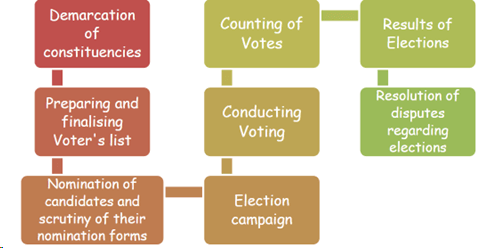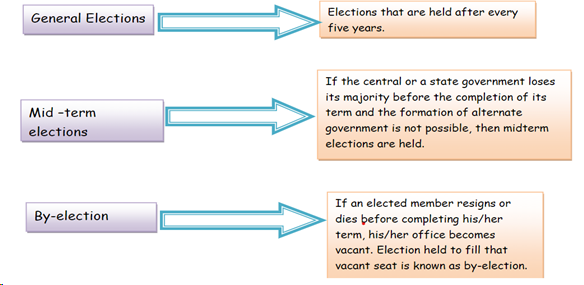General Elections in India 2024 - Electoral Process, Voting, Campaigns, Total Seats, EVM Machines

Discover the role of the Election Commission, electoral systems, and the transition from ballot boxes to EVM machines. Read this blog to learn more about the importance of voter turnout and citizen participation in shaping the nation's future.
By Topperlearning Expert 11th Apr, 2024 | 11:07 am
ShareRohini, a class 6 student, was watching the news on TV about the General elections that were planned to take place in April and May 2024. Panel discussions were held on the likely outcome of the General Elections and the political party that was likely to win the majority in the elections.
Rohini recalled that elections had also taken place in her state just eight months ago. She decided to list the differences between the General and State Elections. Can you think of the differences between the two?
A general election is held at the National level in India to choose the ruling political party. The Party that obtains the majority in the Parliament (272 seats or more) forms the government at the centre, and the leader of the Party is elected as the Prime Minister of India.
Assembly elections in India are conducted at the state level to choose the ruling party. The Party that obtains the majority in the state legislative Assembly forms the government, and the leader of the Party is elected as the state’s Chief minister.
Elections are an important part of any democracy. It is only through elections that people choose their representatives in democratic countries.
Many countries became democracies in the 19th and 20th centuries, but not all people had the right to vote initially. For example, in France, all men were given the right to vote in 1848. Before that, men from the rich and landed class had voting rights. Similarly, women had to fight a long battle to secure voting rights. In the United Kingdom, women received voting rights in 1928, while women in France got the right to vote in 1944.
Indian Independence and the First General Elections
India became independent in 1947, and the first General elections were held between October 25, 1951, and February 21, 1952.
It is not easy to organise elections in a large country like India. To ensure that elections are held in a fair manner, the Constitution of India laid down provisions for the constitution of the Election Commission of India. It is an independent body that supervises the process of elections in India. Article 324 in the Indian Constitution established an independent body of the Election Commission consisting of one Chief Election Commissioner and two other commissioners.
The Election Commission does not have a separate staff. Government officers, teachers and other employees help the Commission during the election process.

The Chief Election Commission (CEC) is appointed by the President of India. CEC is not answerable to the President or to the Government of India. The powers of the EC are
- It takes decisions on every matter related to the elections. It announces the date of the elections and the declaration of the results.
- It implements the Code of Conduct and takes action against candidates who violate it.
- It gives the government guidelines that must be followed during the elections.
- When on election duty, government officials work under the supervision of the EC and not the Government.
Restructuring of the Constituency
- The total number of seats in Lok Sabha is 543 seats. Every member is elected from one constituency. This means that there are 543 Lok Sabha constituencies.
- The Election Commission's Delimitation Commission creates constituencies. This powerful organisation does not succumb to political pressure while creating or restructuring constituencies.
- Uttar Pradesh has the highest number of Lok Sabha constituencies, sending 80 representatives to the Lok Sabha. Mizoram, Nagaland, and Sikkim states each have one constituency for the Lok Sabha elections.
Electoral System in India
- India is divided into several areas known as electoral constituencies for the purpose of voting. People living in one constituency elect one representative from their area.
- For example, the country is divided into 543 constituencies in the Lok Sabha elections. One person is elected from each constituency, and he/she is called a Member of Parliament. Each constituency has roughly an equal population.
- Similarly, the state is divided into several constituencies in the State Assembly elections. An elected constituency member is known as a Member of the Legislative Assembly (MLA).
- The same is true for the municipal or panchayat elections. Each village or town is divided into wards, which are like constituencies.
- In India, some constituencies are reserved for people belonging to scheduled castes, scheduled tribes and other economically backward castes. This has been done so that even the most marginal sections of society get a fair chance of representation in the Lok Sabha, State Assembly, Municipal Corporation and Panchayat. In municipal corporations and gram panchayats, one-third of the seats are reserved for women.
Process of Elections

Election Campaign and Voting
- During an election campaign, political parties hold rallies to highlight many local and national issues. They promise voters to correct flaws in the workings of the government machinery. Many slogans are also raised during the campaign.
- During the elections, no party or candidate can bribe or threaten the voters, use government resources for campaigning, or spend more than 25 lakhs individually for the Lok Sabha elections and Rs 10 lakhs for the Assembly elections.
- During elections, electronic voting machines (EVMs) are used in most polling booths. A voter presses a button against the name or symbol of the candidate for whom he/she wants to vote.
- All EVMs are taken to a safe place after the voting is complete. They are opened on the day of the beginning of the counting. Agents of all political parties are present at the time of the counting to ensure a fair count.
- Voter turnout is usually a measure of people's participation in elections. In India, turnout has either remained stable or gone up.
- In India, poor, illiterate and underprivileged people vote in large numbers as compared to the rich and the privileged sections. Common people in India attach a lot of importance to elections.
The Journey from Ballot Boxes to EVM Machines

Let us now look at the differences between the General, Mid-term and By-elections

Conclusion
The year 2024 is a big election year not only in India but also in the world. Globally, more voters than ever in history will head to the polls as at least 64 countries (plus the European Union) representing a combined population of about 49% of the people in the world are meant to hold national elections. Some of the countries where national elections will be held are India, USA, UK, Indonesia, Pakistan, Mexico, South Africa, South Korea and Sri Lanka.
Apart from general elections in India, several state elections will also be held. State elections will be held in Andhra Pradesh, Arunachal Pradesh, Odisha, Sikkim, Haryana, Maharashtra and Jharkhand.
Thus, we can easily say 2024 is the ‘Year of Elections’.
Stay connected to TopperLearning for more such informative reads. Follow us on WhatsApp Channels and get updated on the latest happenings!
More from Education
Important Resources
- Education Franchisee opportunity
- NCERT Solution
- CBSE Class 9 Mathematics
- NCERT Solutions for class 10 Science
- Sample Papers
- CBSE Class 9 Science
- NCERT Solutions for class 10 Maths
- Revision Notes
- CBSE Class 10 Hindi
- CBSE Class 10 English
- CBSE Class 10 English
- CBSE Class 10 Social Studies
- CBSE Class 10 Science
- CBSE Class 10 Mathematics
- Career In Science After 10
- Career In Commerce After 10
- Career In Humanities/Arts After 10
- NCERT Solutions for Class 10
- NCERT Solutions for Class 11
- Business Studies Class 12 CBSE project





